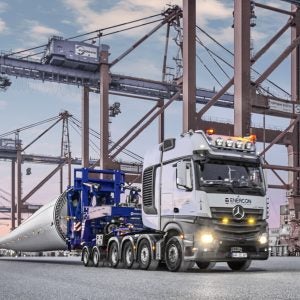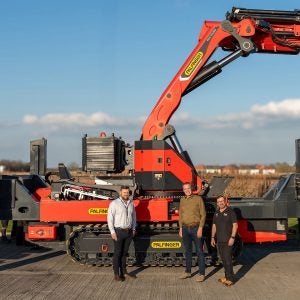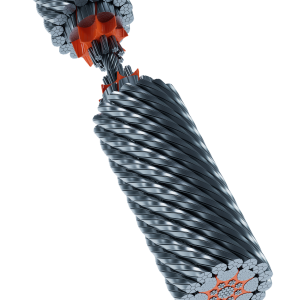An eight-axle LTM 1500 with a seven section, 84-metre telescopic boom, is one of four heavy-duty Liebherr mobile cranes – and the largest in the region – currently involved in the construction of the latest Phase III expansion of the Hong Kong Convention and Exhibition Centre (HKCEC).
The contract for the work on Phase III was awarded to a joint venture between construction companies Hip-Hing, Ngo Kee, Gammon and VSL. Work began in 2006 and is scheduled for completion in 2009.
The supplier of the Liebherr cranes is Kanson Crane & Heavy Transport Co. Ltd., whose Senior Project Engineer Ray C H Tong explained that the new structure being assembled involves some 24,000 t – 25,000 t of parts, making the most heavy duty cranes a must.
“It will reach a height of 80 m and involves individual struts of 20 m in length, weighing up to 180 t each,” he explained. “The plans involve lifting a number of them at one time.”
The Liebherr LTM 1500-8.1 is equipped with a seven-section, 84 m telescopic boom and Its lifting capacities are increased considerably by the boom-suspension.
The lattice jib, reaching lengths of up to 91 metres, extends the operating range of the 500-tonner to 145 m hoisting height and 108 metres reach.
Its carrier is equipped with an eight-cylinder turbo-diesel engine with an output of 500 kW, while the crane engine is a six-cylinder turbo-diesel model with an output of 240 kW.
In total Kanson is using three Liebherr mobile cranes on the project – two LTM 1200/1 plus the LTM 1500-8.1 from its fleet of six Liebherr units. Main contractor Gammon is also using a Liebherr lattice boom LR 1280 with a 280t lifting capacity.
“This is a prestigious project for Liebherr,” said Colin Hughson of Liebherr Hong Kong, “ and at a time when construction projects are generally slow around the world, is an example of Hong Kong’s drive in remaining at the forefront in industries such as conferences and exhibitions. We are happy to be providing Hip-Hing, Ngo Kee Gammon and VSL and Kanson with on-site back-up and support to ensure the project is completed on schedule and on budget.”
Phase I
The original Phase I HKCEC was built on reclaimed land overlooking the Victoria Harbour in 1988. Its three-sided glass curtain was the world’s largest at that time.
Phase II of the HKCEC, completed in 1997 to coincide with the return of Hong Kong’s sovereignty to China, was constructed on a new island of 6.5 hectares and took only 48 months from reclamation to completion. It also won many international design awards for innovation.
About 350,000 m3 of marine mud was dredged in the reclamation project and replaced with 1.8 million m3 of rock and sand. At the same time, seven box-shape structures were built off-site and sunk to the northern seawalls to form the pump houses for the cooling systems of the HKCEC and its associated buildings.
Due to time constraints, piling began almost immediately after land was reclaimed and a total of about 3,000 steel H-piles were driven to an average depth of 40 m.
This work put all of the infrastructure in place for Phase III, and at a further cost of HK$1.3 billion, work is now underway to extend the atrium link between Phases I and II of the HKCEC for the Hong Kong Development Council.
The work will create an additional 19,400 m2 of exhibition space, boosting total dedicated exhibition space by 42% and total rentable space by 30%.
On completion, the HKCEC will have a total of almost 45,500 m2 of internal exhibition space, allowing it to compete against serious new competitors in the region.
Hong Kong needs to respond to evolving trends in the exhibition industry, if it is to maximise the opportunities presented by the rapid economic growth of Mainland China, and in the face of the competition from the Mainland and Macau exhibition industries. The new extension is expected to bring substantial economic benefits to Hong Kong.
It is estimated that the annual quantifiable economic benefits will rise from about HK$176 million in the first year following the opening of the Phase III extension, to about HK$778 million in the fifth year. The number of new jobs created is expected to rise from about 483 in the first year to about 2,131 in the fifth year.
Hong Kong risks losing the large established exhibitions to other venues in the region. The economic impact on Hong Kong of HKCEC losing just one large annual trade exhibition is estimated at around HK$407 million per year.
In terms of employment, this equates to a loss of around 883 full-time equivalent jobs.
For some ‘mega’ trade exhibitions, the organisers have been unable to meet the demand for space even when all the rentable space at HKCEC has been used.
No reclamation works or additional roads were required for the current project, since various traffic improvement measures had already been implemented over the past few years, to help reduce freight movements to and from the HKCEC when major trade fairs are taking place.






